Block Blitz will once again be bringing its hassle-free paving treatments to this year’s GLEE show profiling the start-up’s growing business and its expanding product range on Stand number 20U70.
Originally launched at… Read more
KEY JOBS TO DO IN DECEMBER, JANUARY & FEBRUARY & WHAT TO GROW: One of the most wonderful benefits of owning a Glasshouse or Greenhouse is the ability to extend the growing season – even in winter. A Glasshouse also provides an invaluable tool for the propagation of seeds and cuttings and the over-wintering of tender plants.
Heritage Glasshouse manufacturer Hartley Botanic has provided some useful tips and know-how for Greenhouse gardeners this winter, to help them make the most of their Greenhouses even in the coldest months. Insight has been taken from Hartley Botanic’s online magazine, which provides a wealth of knowledge and inspiration.

DECEMBER
Christmas cuttings
Take root cuttings from plants, like Oriental Poppies, Phlox, Verbascum, ‘Drumstick’ primula’s, shrubs like ‘Japanese Quince’ and exotic ‘Passion Flowers’. Once the leaves have fallen, take a hand fork and carefully tease the soil from around the plant to expose some of the roots. Remove near to the main stem, any that are at least ¼” diameter and as long as possible, but don’t take too many or it weakens the plant. Wash off any soil and cut off any fibrous side roots. Cuttings need to be 2-6” long. For easy identification, make a straight cut at the end nearest the main stem and an angled cut at the base then dust it with fungicide like sulphur to prevent rotting.
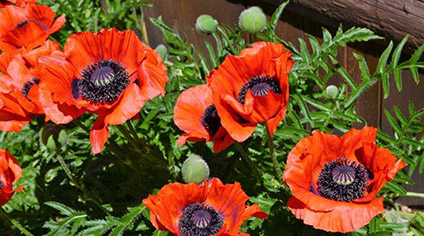
Oriental Poppies
Fill pots of peat substitute compost with added grit and make several holes about 2” apart with a pencil, cane or dibber, insert the cuttings, with the horizontal end just visible at the top, then cover with a thin layer of grit and water. From then on keep the compost moderately moist, don’t overwater it or the roots may rot. Label with the name and date. They take a couple of months to root in a cold frame or cool Greenhouse; put them in a propagator at 65-70 deg F and they will root in a month to six weeks. Water through the summer, feed monthly with a general fertiliser and plant them out the following autumn.
Indoor Christmas flowers
Buy indoor azaleas and poinsettias from the garden centre. Always carry them in a box to prevent them from falling over or being damaged on the journey home.
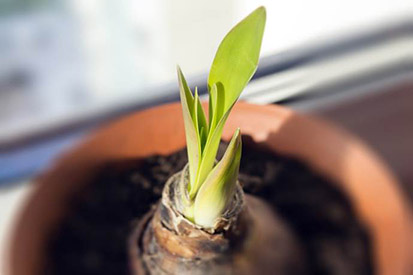
Amaryllis bulb
Start Amaryllis bulbs into growth by watering sparingly at first; just trickle a little tepid water around the bulb, and increase the amount as growth appears. Once they are actively growing, keep them constantly moist but not waterlogged and take care not to get the growth tip wet. They like temperatures between 60-65degF so a warm sunny window is ideal; keep room temperatures cool to prolong the flowering period (this applies to ‘Indian Azalea’s’, ‘Poinsettia’ and ‘Christmas cactus’ too, which should be well away from radiators). Stake the flowering stems carefully to prevent it from falling over and rotate the pot a quarter of a turn each day, then sit back and enjoy the display. Don’t forget to remove any of your houseplants from the windowsill during the night, as they are easily damaged by low temperatures.
JANUARY
Start of the year seeds
With the sudden popularity of gardening, particularly vegetable growing, it is important to put seed orders in early. The sudden increase in demand during lockdown meant that popular varieties sold out quickly and there was a long waiting time on the websites of major suppliers. With several of the ‘big name’ suppliers now owned by one company, consider supporting smaller, independent suppliers – of which there are many – to ensure that we still retain such a wonderful choice, keep the genetic diversity and support small businesses, too. It is a good idea to browse before you buy, so you have a full overview of what’s available.
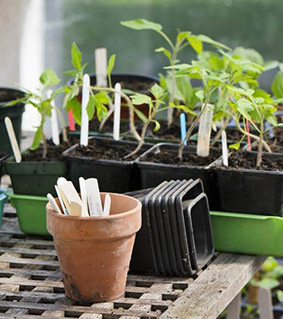
Label your seeds
If you don’t have enough space to grow everything from seed, buy plug plants, which save time, space and reduce Greenhouse heating costs, too. Once you have ordered your seeds and plug plants, write the labels this month and put them together in an elastic band in alphabetical order, then add the date when you sow.
What to grow…
If you have a heated Greenhouse, aubergines can be sown at 18-21°C (65-70°F) late in the month in pots or modules of peat-free seed sowing compost in a propagator. Once the seeds have germinated, grow lights, will maintain compact growth. Antirrhinums, lobelia, can be sown in a heated propagator at a minimum of 21-24C (70-75F). Lightly cover geranium seed with fine grade vermiculite. Begonia should be sown on the surface of moist compost and left uncovered as they need light to germinate. Sow summer cauliflowers and make small sowings of onions, radish and early carrots in a cold Greenhouse towards the end of January. Peas, lettuce and radish can be sown in Greenhouse borders.
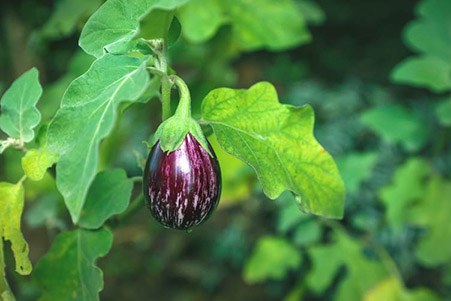
Sew aubergines at 18-21°C
If you missed sowing broad beans in autumn, sow some now under glass for an early summer harvest, 5-8cm apart and 2.5cm deep in deep trays of peat multipurpose compost or singly in small pots. Put them in a cool frost-free Greenhouse, and ‘harden off’ before planting outdoors in early spring. ‘The Sutton’ and ‘Robin Hood’ are dwarf and ideal for windy sites; ‘Aquadulce’ and ‘Aquadulce Claudia’ are taller traditional varieties.
Water plants showing signs of drought, giving them just enough to prevent desiccation, water in the morning so the compost dries out before evening.
Strawberries that were lifted and potted up last summer, can now be brought into the Greenhouse and put on the bench for maximum light. When they start flowering, pollinate them by transferring pollen from one flower to another using a fine artists brush. Keep the compost moist and feed with dilute tomato fertiliser every two weeks to encourage flowering and fruiting. They can be ‘hardened off’ and planted outdoors in mid spring.
FEBRUARY
February pruning
If you are growing C. orientalis and C.tangutica; Clematis texensis, Clematis viticella and their cultivars and the large flowered hybrids like ‘Hagley Hybrid’ and ‘Perle d’Azure’, now’s the time to prune. This group flowers in summer and autumn on the current year’s stems, so select the strongest pair of buds near the base and cut just above them to remove all of the previous year’s growth. Feed, water and mulch when the first growth appears and look forward to the first flush of flowers later in the year.
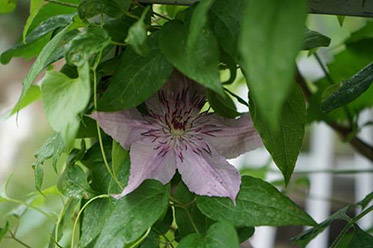
‘Hagley Hybrid’ – now is the time to prune
Now is time for potatoes
There’s now a good selection of potatoes in garden centres, catalogues and on the internet. Sprouting or ‘chitting’ early potatoes before planting is useful for earlier varieties in cooler climates and maincrop potatoes if they’re being planted late. Put a layer of seed potatoes in a seed tray or egg box, ‘rose end’ up – you’ll see a cluster of small hollows or ‘eyes’ at one end. Pop the tray in a cool, light, frost free place and wait for them to sprout. After six weeks at 7C, the shoots will be about 2.5cm long and ready for planting. If the shoots are longer, handle them with care, as they break off easily. If you want a smaller crop of larger potatoes leave the three strongest shoots otherwise leave them alone. Even if you don’t have room for a large crop, grow ‘earlies’ in a flowerpot at least 30cm diameter, an old dust bin or a black bin liner.
Other vegetables…
If you’re preparing to sow vegetables, warm the soil with polythene or a cloche for a couple of weeks before sowing. This raises the temperature by a few degrees and dries off the surface making a warm, crumbly seedbed that’s perfect for the germinating seeds. It is worth investing in a soil thermometer, to check temperatures below the surface, too.
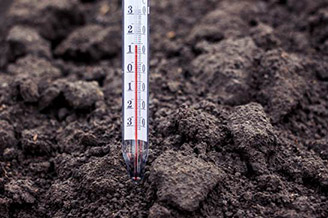
It’s worth investing in a soil thermometer
Shallots need a long growing season and can be planted from mid-January in mild areas on free draining soils; in other areas, leave them a little later, into February when the soil is workable. Plant ‘virus free’ bulbs with a trowel, 18cm apart each way, leaving the shoot tips just poking out of the soil. If they are lifted by frost or picked out by the birds, replant them again rather than just pushing the bulbs back into the soil, then you’ll cause less damage to the roots. If the birds continue to be a nuisance, cover the area with horticultural fleece.
February 101
PRUNE
PLANT
HARVEST
MISCELLANEOUS
A final word on ventilation
Open Greenhouse vents for as long as possible on mild sunny days over winter, shutting them before temperatures drop early in the afternoon. A combination of high temperatures and low light makes leaves and stems soft, spindly and prone to grey mould which spreads rapidly in cool, damp conditions. Though good air circulation is vital, avoid chilling draughts, don’t leave the door open and always err on the side of caution!
Founded by brothers Vincent (RHS fellow) and Norman Hartley, the company was (to its knowledge) the first to develop and make entirely aluminium Greenhouse structures, marking a huge improvement on its wood and wrought iron Victorian forerunners. Since then, Hartley Botanic has built a name and reputation amongst the horticultural elite synonymous with excellence, thanks to its incomparable range, its structurally superior Greenhouses which ‘last a lifetime’ and its exceptional service delivery. In February 2017 Hartley Botanic became the only aluminium Glasshouse and Greenhouse manufacturer to be endorsed by the RHS. It is the Greenhouse manufacturer of choice for leading horticulture organisations, institutions and designers in the UK and worldwide with Hartley Botanic commissioned by the RHS, the National Trust, Kew Gardens, Glasgow Botanic Gardens, Massachusetts Horticultural Society, Oxford Botanical Gardens, Le Manoir aux Quat'Saisons, Blenheim Palace, The Lingholm Estate and Hampton Court Palace...to name a few.
‘Why Hartley?’
Unrivalled. Unparalleled. Unique. There are Glasshouses, and there are Hartley Botanic Glasshouses. Combining inspired design with enduring quality, nothing quite enhances your garden like a Hartley Botanic. The manufacturer prides itself on five key pillars of service which sets it apart:
1. Beauty and Elegance
The incomparable range of simply beautiful and elegant structures means Hartley Botanic can create designs that are distinctive and unique. The Victorian, Heritage and Modern Glasshouse ranges are so comprehensive you don’t have to go anywhere else to find your beautifully crafted, high-quality Glasshouses from the widest of choices.
2. Structurally Superior
Every Hartley Botanic Glasshouse is handmade in the North of England to your exact requirements. It is made of the finest materials with unparalleled durability, safety, and beauty. All of the aluminium sections have a structural purpose. Short cuts, such as ‘sticking’ aluminium to glass for aesthetic reasons, are never taken. Hartley Botanic are so confident of the structural integrity of their Greenhouses; a 30-year Lifetime Guarantee is offered.
3. A Reputation Beyond Compare
Hartley Botanic’s brand heritage and reputation have been built on trust for over 80 years. They have earned an unrivalled reputation for crafting the finest Glasshouses and Greenhouses money can buy through the very highest standards of hard-won experience, craftsmanship and service.
4. Unrivalled Knowledge and Expertise
There is a wealth of knowledge and expertise built into every Hartley Botanic Glasshouse. Generations of customers have put their trust in the hands of expert, time served, highly skilled craftsmen. Glasshouses of distinction are created from decades of knowledge and care.
5. Exceptional Delivery of Service
Once your order has been handmade to your personal requirements, and Hartley Botanic’s exacting standards, your delivery and installation will be exceptional. The proud team at Hartley Botanic are there to ensure the process runs smoothly, providing you with the information you need and keeping you up to date throughout.
All Hartley Botanic’s Glasshouses and Greenhouses are handmade, bespoke and made to order. Customers interested in purchasing a Hartley Botanic Greenhouse should visit: https://www.hartley-botanic.co.uk or call 01457 819 155 for more information. Visit: https://hartley-botanic.co.uk/magazine/
Copyright © 2026. All rights reserved.
Designed By Euromedia Associates Ltd